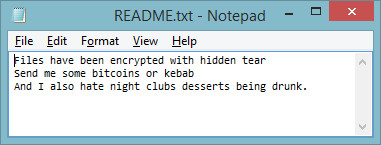RANSOM_HIDDENTEARBKDR.A
Ransom:MSIL/Ryzerlo.A (Microsoft)
Windows


Threat Type: Worm
Destructiveness: No
Encrypted: No
In the wild: Yes
OVERVIEW
This worm arrives via removable drives. It arrives on a system as a file dropped by other malware or as a file downloaded unknowingly by users when visiting malicious sites.
It listens on port(s). It executes commands from a remote malicious user, effectively compromising the affected system. It connects to a website to send and receive information.
TECHNICAL DETAILS
Arrival Details
This worm arrives via removable drives.
It arrives on a system as a file dropped by other malware or as a file downloaded unknowingly by users when visiting malicious sites.
Installation
This worm drops the following files:
- %Desktop%\README.txt - Ransom Note
(Note: %Desktop% is the desktop folder, where it usually is C:\Documents and Settings\{user name}\Desktop in Windows 2000, Windows Server 2003, and Windows XP (32- and 64-bit); C:\Users\{user name}\Desktop in Windows Vista (32- and 64-bit), Windows 7 (32- and 64-bit), Windows 8 (32- and 64-bit), Windows 8.1 (32- and 64-bit), Windows Server 2008, and Windows Server 2012.)
It drops the following copies of itself into the affected system:
- %System%\msmgr.exe
(Note: %System% is the Windows system folder, where it usually is C:\Windows\System32 on all Windows operating system versions.)
It adds the following mutexes to ensure that only one of its copies runs at any one time:
- msmgr.201
Autostart Technique
This worm modifies the following registry entry(ies) to enable its automatic execution at every system startup:
HKEY_LOCAL_MACHINE\SOFTWARE\Microsoft\
Windows NT\CurrentVersion\Winlogon
Userinit = "%System%\Userinit.exe, %System%\msmgr.exe"
(Note: The default value data of the said registry entry is "%System%\Userinit.exe".)
Propagation
This worm drops the following copy(ies) of itself in all removable drives:
- {Drive Letter}:\My Pictures.exe
- {Drive Letter}:\My Pictures\My Pictures.exe - if above already exists
Backdoor Routine
This worm listens on the following port(s):
- 13000
It executes the following commands from a remote malicious user:
- cmd.exe /C {Received Information}
- Display {Received Information} via Message Box
It connects to the following websites to send and receive information:
- http://{BLOCKED}.{BLOCKED}.243.217/crypt.php?key={Generated Passowrd} {Host Name}-{Computer Name}
Other Details
This worm encrypts files with the following extensions:
- .txt
- .doc
- .docx
- .xls
- .xlsx
- .ppt
- .pptx
- .odt
- .jpg
- .png
- .csv
- .sql
- .mdb
- .sln
- .php
- .asp
- .aspx
- .html
- .xml
- .psd
It renames encrypted files using the following names:
- {host file}.locked
NOTES:
It encrypts files in the following directories:
- %Desktop%
It tries to send an email to {BLOCKED}l@e{BOCKED}l.com with the following composition:
Subject Test Mail
body:
{Computer Name}\{User Name}
{host ip}
{host public ip}
It sets the following file time of the drop copy of itself in non-fixed drives:
Creation time:
10/02/1992 - 02:18:21
Last Write Time:
11/04/1992 - 02:21:07

SOLUTION
Step 1
Before doing any scans, Windows XP, Windows Vista, and Windows 7 users must disable System Restore to allow full scanning of their computers.
Step 2
Note that not all files, folders, and registry keys and entries are installed on your computer during this malware's/spyware's/grayware's execution. This may be due to incomplete installation or other operating system conditions. If you do not find the same files/folders/registry information, please proceed to the next step.
Step 3
Identify and terminate files detected as RANSOM_HIDDENTEARBKDR.A
- Windows Task Manager may not display all running processes. In this case, please use a third-party process viewer, preferably Process Explorer, to terminate the malware/grayware/spyware file. You may download the said tool here.
- If the detected file is displayed in either Windows Task Manager or Process Explorer but you cannot delete it, restart your computer in safe mode. To do this, refer to this link for the complete steps.
- If the detected file is not displayed in either Windows Task Manager or Process Explorer, continue doing the next steps.
Step 4
Restore these modified registry values
Important:Editing the Windows Registry incorrectly can lead to irreversible system malfunction. Please do this only if you know how to or you can seek your system administrator's help. You may also check out this Microsoft article first before modifying your computer's registry.
- In HKEY_LOCAL_MACHINE\SOFTWARE\Microsoft\Windows NT\CurrentVersion\Winlogon
- From: Userinit = "%System%\Userinit.exe, %System%\msmgr.exe"
To: Userinit = %System%\msmgr.exe
- From: Userinit = "%System%\Userinit.exe, %System%\msmgr.exe"
Step 5
Search and delete this file
- %Desktop%\README.txt
Step 6
Scan your computer with your Trend Micro product to delete files detected as RANSOM_HIDDENTEARBKDR.A. If the detected files have already been cleaned, deleted, or quarantined by your Trend Micro product, no further step is required. You may opt to simply delete the quarantined files. Please check this Knowledge Base page for more information.
Did this description help? Tell us how we did.



